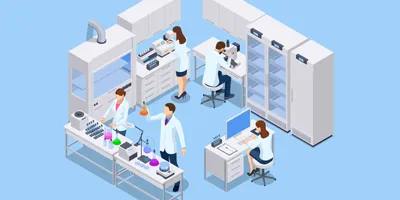Laboratory productivity is often framed as a people problem. If only staff worked faster, stayed more focused, or managed their time better, output would rise. But organizational research—including workflow studies in healthcare and other complex environments—shows the opposite: productivity depends far more on systems than on individuals. When workflows are poorly designed, even the most skilled scientists will struggle to deliver results.
For lab managers, the challenge is not pushing employees harder but creating processes that remove friction, reduce wasted effort, and enable teams to do their best work. As Harvard Business Review notes, “productivity is about your systems, not your people.”
Map laboratory workflows to eliminate bottlenecks
Every lab relies on repeatable processes: sample intake, experiment setup, equipment calibration, data recording, and reporting. Bottlenecks often emerge when steps are poorly defined or rely on manual coordination.
Workflow mapping helps managers identify pain points and visualize handoffs. For example:
- Sample intake: Delays can arise when technicians must wait for multiple approvals. Streamlining to a single accountable sign-off can cut turnaround times significantly.
- Equipment scheduling: Without a centralized booking system, instruments may sit idle while staff argue over access. A shared scheduling platform ensures transparency and maximizes uptime.
- Data handoffs: Manual transcription of results introduces errors and wastes time. Automating data capture directly into a lab information management system (LIMS) both accelerates reporting and improves accuracy.
By documenting and analyzing workflows, managers can turn hidden inefficiencies into clear opportunities for improvement.
Standard operating procedures drive laboratory efficiency
Inconsistent processes lead to confusion, duplication, and errors. Standard operating procedures (SOPs) establish a reliable baseline, ensuring that tasks are carried out the same way every time. This consistency is especially important for compliance, reproducibility, and quality assurance.
However, standardization should not be mistaken for rigidity. Effective SOPs include built-in flexibility, such as escalation paths or alternative methods, so staff can adapt when unexpected issues arise. The goal is to create a foundation that eliminates unnecessary variation while still allowing for professional judgment.
Use technology tools to streamline laboratory operations
Digital tools can transform how labs manage resources and share information. Consider:
- LIMS and electronic lab notebooks (ELNs) that automate data capture, reduce transcription errors, and create searchable archives
- Inventory management systems that track reagents, chemicals, and consumables in real time, reducing stockouts and over-ordering
- Automation and robotics that free staff from repetitive tasks such as pipetting or plate handling, enabling them to focus on higher-value activities
These tools not only improve speed but also build resilience into workflows by reducing reliance on manual coordination. Modern digital lab platforms, such as integrated asset-management and ELN systems, enable labs to move from reactive troubleshooting to proactive oversight, boosting uptime, enabling maintenance before breakdowns, and preventing operational disruptions.
Clarify ownership and reduce handoffs in lab processes
Handoffs are one of the most common sources of delay and error in laboratory workflows. Every time a task moves from one person to another, there is potential for miscommunication, rework, or lost time.
Lab managers can address this by:
- Assigning clear ownership of each process step
- Reducing the number of required sign-offs
- Creating cross-functional teams that manage a process end-to-end
Clarity around ownership not only accelerates workflows but also strengthens accountability and engagement among staff.
Strengthen communication to support laboratory productivity
Even the most carefully mapped workflows depend on clear communication. Without it, approvals stall, handoffs get lost, and accountability weakens.
Lab managers can strengthen communication by:
- Setting clear expectations: Define who is responsible for each task, and communicate deadlines upfront
- Creating consistent channels: Use a single platform or protocol for logging updates, reporting issues, and sharing decisions; multiple, ad hoc channels create confusion
- Encouraging transparency: Regular check-ins, whether through daily huddles or weekly updates, keep the team aligned on progress and potential roadblocks
- Documenting decisions: Recording process changes, approvals, or lessons learned in a shared system ensures knowledge doesn’t get lost when staff rotate or turnover occurs
When communication flows as reliably as the processes themselves, labs can reduce delays, minimize errors, and build trust among team members.
Build continuous feedback loops for process improvement
Even the most carefully designed process will drift over time if not regularly assessed. Building in feedback loops helps managers spot new bottlenecks and continuously refine systems.
Practical approaches include:
- Regular team debriefs to discuss what is working and what is slowing progress
- Dashboards or KPIs that track turnaround time, error rates, and equipment utilization
- Anonymous feedback channels that encourage staff to raise concerns without fear of blame
This continuous improvement mindset—similar to Lean and Six Sigma methodologies—keeps systems aligned with evolving research needs, staffing levels, and compliance requirements.
Shift from firefighting to foresight in lab management
Too often, lab managers spend their days putting out fires: addressing broken equipment, missing samples, or delayed approvals. A systems-focused approach shifts the emphasis from firefighting to foresight.
When processes are well designed, common problems become predictable and preventable. Managers can then devote their energy to strategic priorities such as mentoring staff, fostering collaboration, and planning for future research directions.
Advanced Lab Management Certificate
The Advanced Lab Management certificate is more than training—it’s a professional advantage.
Gain critical skills and IACET-approved CEUs that make a measurable difference.
Conclusion
Productivity in the lab is not about urging people to work harder—it is about creating systems that let them work smarter. By mapping workflows, standardizing processes, leveraging technology, reducing handoffs, strengthening communication, and building feedback loops, lab managers can eliminate bottlenecks and unlock their team’s full potential.
Strong systems don’t just drive results—they also reduce frustration, improve morale, and create an environment where scientists can do their best work.













